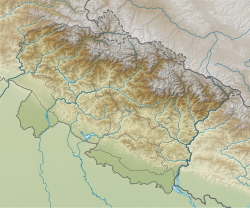| UNESCO World Heritage Site | |
|---|---|
 View of the Valley of Flowers | |
| Location | Chamoli District, Uttarakhand, India |
| Part of | Nanda Devi and Valley of Flowers National Parks |
| Reference | 335-002 |
| Inscription | 1988 (12th Session) |
| Extensions | 2005 |
| Area | 8,750 ha (33.8 sq mi) |
| Coordinates | 30°43′48″N79°37′03″E / 30.73000°N 79.61750°E |
Valley of Flowers National Park is an Indian national park which was established in 1982. It is located in Chamoli in the state of Uttarakhand and is known for its meadows of endemic alpine flowers and the variety of flora. This richly diverse area is also home to rare and endangered animals, including the Asiatic black bear, [1] snow leopard, [1] musk deer, [1] brown bear, red fox [1] and blue sheep. Birds found in the park include Himalayan monal pheasant and other high-altitude birds. [2]
Contents
- History
- Documented explorers
- Timeline
- Geoclimatic
- Location
- Geography
- Climate
- Ecology
- Biodiversity
- Flora
- Fauna
- Conservation
- Conservation management
- Research nursery and seed bank
- See also
- References
- Further reading
- External links
At 3,352 to 3,658 meters above sea level, the gentle landscape of the Valley of Flowers National Park complements the rugged mountain wilderness of Nanda Devi National Park to the east. [3] Together, they encompass a unique transition zone between the mountain ranges of the Zanskar and Great Himalayas. The park stretches over 87.50 km2 and is about 8 km long and 2 km wide. [2] It lies completely in the temperate alpine zone. Both parks are encompassed in the Nanda Devi Biosphere Reserve (223,674 ha) which is further surrounded by a buffer zone (5,148.57 km2). [4] Nanda Devi National Park Reserve is in the UNESCO World Network of Biosphere Reserves.
The park is open only during summer from June to October and is covered by heavy snow for the rest of the year. [1]



















